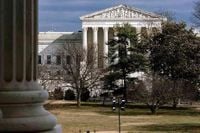On October 3, 2025, the U.S. Supreme Court announced it would wade into one of the most contentious debates in American law—whether states like Hawaii can bar people with concealed carry permits from bringing handguns onto private property open to the public, such as stores, malls, and restaurants, unless the property owner grants explicit permission. This decision to hear the case comes at a time when the nation’s highest court is already set to tackle several hot-button issues, from race-based redistricting to transgender athlete laws and campaign finance, promising a term of enormous consequence, according to CNN.
The legal battle at the Court’s doorstep centers on a 2023 Hawaii law, crafted in direct response to the Supreme Court’s landmark 2022 ruling in New York State Rifle & Pistol Association v. Bruen. That decision expanded gun rights by striking down New York’s requirement that residents show “proper cause” to carry a handgun, and it set a new standard: modern gun regulations must be “consistent with this nation’s historical tradition of firearm regulation.” This historical test has since become a lightning rod, prompting a flurry of lawsuits and forcing federal judges into the role of amateur historians, as CNN noted.
Hawaii’s law, however, flipped the script. Where previously, someone with a concealed carry permit could bring their handgun into a store unless the owner explicitly prohibited it, the new law requires “express authorization”—written or verbal—from the property owner. The measure also bars guns in so-called “sensitive locations,” including beaches, parks, playgrounds, bars, and restaurants that serve alcohol. Four other states—California, Maryland, New Jersey, and New York—have enacted similar laws, requiring property owners to post clear signs or grant permission if they wish to allow firearms on their premises, as reported by CBS News and CNN.
The challenge to Hawaii’s law was brought by the Hawaii Firearms Coalition and three gun owners who hold concealed carry permits. They argue that the law, and the subsequent 9th Circuit Court of Appeals decision upholding it, render “illusory the right to carry in public.” Their attorney, Alan Beck, summed up their frustration: “I believe the Supreme Court will find this onerous law violates the Second Amendment,” he told Reuters. Beck also argued that the law “effectively bans the carry of firearms in metropolitan areas,” making it nearly impossible for permit holders to run ordinary errands without risking criminal charges.
Backing the challengers is the Trump administration, which filed a brief urging the Supreme Court to take up the case. Solicitor General D. John Sauer argued that Hawaii’s restriction is so sweeping that “a person carrying a handgun for self-defense commits a crime by entering a mall, a gas station, a convenience store, a supermarket, a restaurant, a coffee shop, or even a parking lot.” He warned that because few property owners post signs either allowing or forbidding guns, Hawaii’s default rule “functions as a near-complete ban on public carry.”
The Department of Justice, under President Trump, further pressed the point by drawing a colorful comparison: “People could bring bicycles, roller skates, protest banners, muddy shoes, dripping umbrellas, melting ice cream cones into private stores without permission. Only if someone wants to carry a gun must he obtain ‘express authorization’ under the arbitrary presumption that all property owners would view guns differently.”
On the other side, Hawaii officials and gun safety advocates argue that the law is a measured, constitutional response to the Supreme Court’s own precedent. Anne Lopez, Hawaii’s Democratic attorney general, defended the law as “a permissible effort to vindicate the rights of Hawaii’s citizens to exclude armed individuals from their private property.” Hawaii’s lawyers told the Supreme Court that the Second Amendment “protects ‘an individual right to keep and bear arms for self-defense.’ It does not override a property owner’s fundamental right to exclude.”
Janet Carter, managing director of Second Amendment Litigation at Everytown Law, echoed this sentiment, telling CBS News, “The Ninth Circuit was absolutely right to say it’s constitutional to prohibit guns on private property unless the owner says they want guns there.” The gun safety group Everytown urged the Supreme Court to uphold Hawaii’s measure, emphasizing the importance of property rights and public safety.
The legal journey to the Supreme Court has been winding. After Hawaii’s law was enacted in 2023, a federal district court initially barred its enforcement. But the San Francisco-based 9th Circuit Court of Appeals reversed that decision, allowing Hawaii to enforce the law. In a unanimous opinion, the appeals court wrote, “Nothing in the text of the Second Amendment or otherwise suggests that a private property owner—even owners who open their private property to the public—must allow persons who bear arms to enter.”
This case marks the first time since Bruen that the Supreme Court will directly address the reach of its new historical test for gun regulations. The justices have already shown a willingness to both expand and limit gun rights, depending on the context. Since 2022, the Court has struck down a Trump-era ban on bump stocks, upheld a Biden administration ban on ghost guns, and, in 2024, upheld a federal law barring guns for people subject to domestic violence restraining orders—even though there was no such law at the nation’s founding. Chief Justice John Roberts, writing for an 8-1 majority in that case, noted that the nation did have a history of disarming “individuals who present a credible threat to the physical safety of others.”
The stakes in the Hawaii case are high—not just for Hawaii, but for the handful of other states with similar laws and potentially for the broader landscape of American gun regulation. If the challengers win, businesses could still post signs or verbally prohibit guns, but the default would shift, making it easier for permit holders to carry firearms in public spaces. If Hawaii prevails, states will have more leeway to restrict where guns can be carried, even on private property open to the public.
The Supreme Court is expected to hear arguments early in its new nine-month term, which starts on October 6, 2025. A decision is likely by late June or early July 2026. As the justices prepare to weigh in, both sides are bracing for a ruling that could reshape the balance between gun rights, property rights, and public safety across the country.
With the nation deeply divided over how best to address gun violence and the scope of the Second Amendment, the outcome of this case will be closely watched—not just by legal scholars, but by millions of Americans whose daily lives could be affected by the Court’s decision.





